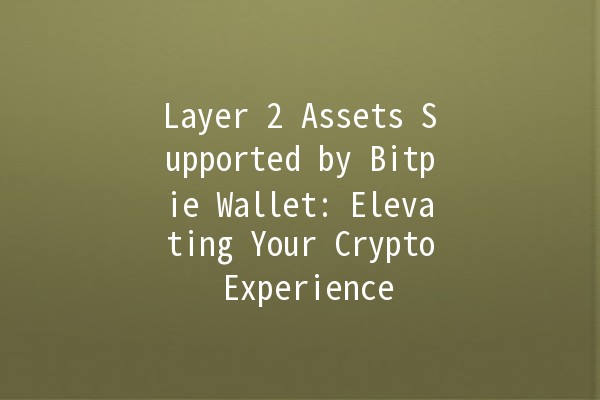




In the fastevolving world of cryptocurrency, wallets play a crucial role in how users interact with their assets. Among various wallets available today, Bitpie Wallet stands out for its robust support of Layer 2 assets, allowing users to manage their digital currencies more efficiently and with lower transaction fees. This article will delve into the topic of Layer 2 assets supported by Bitpie Wallet, explaining what they are and how they enhance the overall crypto experience. We will explore five productivityboosting techniques for using Bitpie effectively, ensuring a smooth and profitable interaction with Layer 2 assets.
Layer 2 solutions refer to protocols built on top of existing blockchain networks (Layer 1) to enhance scalability and transaction throughput. They alleviate the congestion on the main blockchain by processing transactions offchain, thus significantly reducing costs and improving speeds.

Some noteworthy Layer 2 solutions include:
Lightning Network (for Bitcoin): This solution enables fast transactions and low fees by creating payment channels.
Optimistic Rollups: These use fraud proofs to process transactions offchain but ultimately ensure transaction validity via the main chain.
Plasma Framework: This allows users to create child chains that can process transactions quicker than the main Ethereum chain.
Bitpie Wallet ensures that users can take full advantage of Layer 2 solutions, supporting a variety of assets that enhance the crypto experience. Here's a list of notable Layer 2 assets you can manage with Bitpie:
Bitpie Wallet offers an inapp swapping feature that allows users to seamlessly exchange one cryptocurrency for another without needing to go through a centralized exchange.
How to Use It:
Navigate to the swap section within the Bitpie Wallet.
Select the coins you want to exchange.
Confirm and execute your transaction instantly.
This feature saves time and minimizes transaction costs, especially useful for Layer 2 assets where fees are optimized.
For users who hold significant amounts of Layer 2 assets, implementing multisignature (multisig) transactions can enhance security.
How to Implement:
Within Bitpie Wallet settings, set up a multisig configuration requiring multiple confirmation signatures before transactions can be executed.
This provides an additional layer of security against unauthorized access.
Multisig is particularly beneficial for organizations or collective investors managing shared assets.
Given the growing interoperability in crypto, Bitpie Wallet enables users to engage in crosschain transactions effectively.
Steps to Follow:
Use the wallet's features to make transactions between Layer 1 and Layer 2 assets seamless.
Stay informed about the crosschain compatibility of different Layer 2 solutions compatible with Bitpie.
Crosschain capabilities enhance liquidity and flexibility, allowing users to diversify their portfolios efficiently.
Managing a portfolio of Layer 2 assets can be streamlined by utilizing Bitpie Wallet's builtin performance tracking tools.
Practical Tip:
Regularly check the portfolio performance and analytics available in Bitpie.
Leverage this information to make informed decisions about buying and selling assets, especially during volatile market conditions.
A proactive approach to performance tracking can lead to heightened productivity as users stay informed about market trends.
Many Layer 2 solutions allow for decentralized finance (DeFi) applications, offering users the chance to earn yields on their holdings.
How to Engage:
Research DeFi projects supported by Layer 2 assets within the Bitpie ecosystem.
Participate in liquidity farming or staking to earn passive income.
Engaging in DeFi while utilizing Bitpie Wallet can significantly enhance user productivity, facilitating a thriving crypto investment experience.
Bitpie Wallet supports various Layer 2 assets, including Polygon (MATIC), Lightning Bitcoin (LBTC), Loopring (LRC), Arbitrum, and xDai. Keeping your Layer 2 assets secured in Bitpie allows for efficient management and easy access.
While Layer 2 solutions significantly reduce transaction fees compared to their Layer 1 counterparts, there may still be nominal fees associated with certain transactions. These costs depend on the network traffic and specific transaction types, so it’s always good to stay updated.
To enhance security, you can enable features such as multisignature transactions, use strong passwords, and enable twofactor authentication in Bitpie Wallet. Regularly updating your application can also protect against vulnerabilities.
Yes, Bitpie Wallet offers an inapp swapping feature that allows you to easily exchange Layer 2 assets with traditional cryptocurrencies like Bitcoin or Ethereum. This can be done seamlessly within the app.
It’s advisable to check your asset performance regularly, especially during major market fluctuations. Utilizing Bitpie's portfolio tracking features can help you make informed decisions regarding your investments.
While Layer 2 solutions offer scalability and lower costs, users should remain aware of potential risks, including security vulnerabilities, network fluctuations, and regulatory uncertainties. It's essential to conduct thorough research and stay informed about the networks you are using.
The above insights highlight not only the capabilities of Bitpie Wallet but also provide practical strategies for maximizing productivity when managing Layer 2 assets. With the emergence of an expansive array of Layer 2 solutions and the benefits they bring to the cryptocurrency landscape, users equipped with the right tools and knowledge can navigate this evolving space with confidence and efficiency.